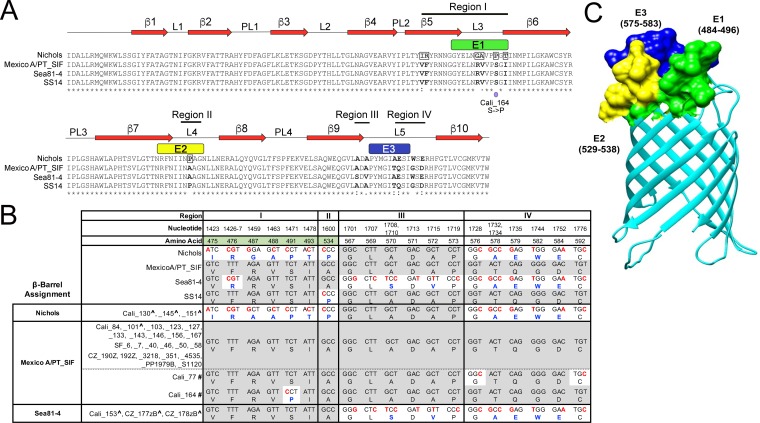FIG 3 .
T. pallidum subsp. pallidum in clinical samples from Cali, San Francisco, and the Czech Republic encodes Nichols, Mexico A/PT_SIF, or Sea81-4 TprC allele β-barrel domains. (A) Multiple-sequence alignment of the four TprC allele β-barrels identified in T. pallidum subsp. pallidum reference genomes. The Mexico A and PT_SIF TprC allele β-barrel sequences are identical and are referred to here as Mexico A/PT_SIF. Identical amino acids are indicated by asterisks (*); nonsynonymous amino acid substitutions are in bold. Double dots (:) and single dots (⋅) indicate highly conservative and conservative changes, respectively. Amino acids that were positively selected in the branch-site model using PAML (57) are boxed in the Nichols allele sequence. Numbered red arrows and black lines indicate the positions of predicted β-strands, periplasmic loops (PL), and extracellular loops (L) in the Nichols TprC allele β-barrel structural model shown in panel C. A purple dot indicates a nonsynonymous nucleotide substitution in the Mexico A allele β-barrel variant-encoding region for Cali_164. (B) Nucleotide and amino acid differences, shown in red and blue, respectively, in the TprC allele β-barrels and variants identified in T. pallidum subsp. pallidum reference genomes and 31 clinical strains, respectively. The nucleotide and amino acid numbers for variable positions are based on full-length T. pallidum subsp. pallidum Nichols TprC (Fig. S2). Consensus positions are shaded gray. Positively selected amino acids identified by the branch-site model using PAML (57) are shaded green. Carat symbols (^) indicate clinical strains belonging to the Nichols clade (see Table 1). Hash marks (#) designate Mexico A allele TprC β-barrel variants (Cali_77 and Cali_164). (C) The TMBpro webserver (58) was used to generate a three-dimensional structural model for the β-barrel of TprC (Nichols). B-cell epitopes E1 (residues 484 to 496), E2 (residues 529 to 538), and E3 (residues 575 to 583) predicted by DiscoTope 2.0 (59) are shown in green, yellow, and dark blue.

